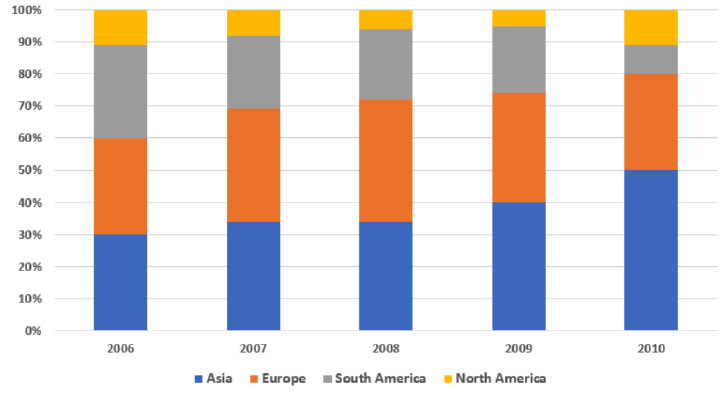
Bài mẫu
The bar chart illustrates the comprehensive sales data of an automotive manufacturer across four distinct regions spanning the years from 2002 to 2006.
It is evident that the Asian market exhibited a steady upward trajectory throughout the specified timeframe, whereas North American sales witnessed a consistent decline. Meanwhile, the remaining regions displayed comparatively minor fluctuations. Notably, the combined sales of Europe and Africa outstripped the rest, emerging as the primary contributors to the manufacturer’s overall revenue.
Initially, European and African sales accounted for 44% of the company’s total revenue, maintaining a marginal lead over the North American market by 11%. Concurrently, both Asia and South America shared relatively similar proportions of the manufacturer’s sales, representing 12% and 11% respectively.
Over the ensuing four years, the dominance of the European and African markets in the manufacturer’s sales revenue persisted, peaking at 48% in 2004 before experiencing a subsequent decline to 40% by 2006. Conversely, South American sales plummeted to a nadir of 6% in 2004, rebounding to its initial level in the following 2 years, consistently maintaining the lowest share among all regions. Meanwhile, the Asian market witnessed a gradual ascent, while North American sales steadily dwindled, resulting in a narrowing gap between the market shares of these two regions, culminating at 28% and 21% respectively by the end of the period.
[stu alias=”khoa_truy_cap_cac_bai_giai_de”]Từ vựng tốt trong bài
- exhibit a steady upward trajectory (v): xu hướng đi lên
Giải thích: to demonstrate consistent progress or improvement over time.
Ví dụ: The company exhibited a steady upward trajectory in its sales figures quarter after quarter.
- timeframe (n): khung thời gian
Giải thích: a period of days, weeks, months, etc. within which an activity is intended to happen
Ví dụ: Have you set a time frame for completing the job?
- witness a consistent decline (v): chứng kiến sự giảm dần ổn định
Giải thích: to observe a continuous decrease over a period of time
Ví dụ: The attendance at the event witnessed a consistent decline over the past few years.
- comparatively (adv): tương đối
Giải thích: as compared to something else
Ví dụ: We couldn’t afford it and yet we’re comparatively well off.
- ensuing (adj): kế tiếp theo
Giải thích: happening after something and because of it
Ví dụ: An argument broke out and in the ensuing fight, a gun went off.
- plummet (v): rơi thẳng xuống, tụt xuống
Giải thích: to fall very quickly and suddenly
Ví dụ: House prices have plummeted in recent months.
- a nadir of (n): mức thấp nhất
Giải thích: the worst moment, or the moment of least hope and least achievement
Ví dụ: The defeat was the nadir of her career.
- rebound (v): phục hồi
Giải thích: to return to an earlier and better condition; improve
Ví dụ: Older athletes find it harder to rebound from injuries.
- dwindle (v): thu nhỏ lại, suy yếu dần
Giải thích: to become smaller in size or amount, or fewer in number
Ví dụ: The community has dwindled to a tenth of its former size in the last two years.
Lược dịch tiếng Việt
Biểu đồ minh họa dữ liệu bán hàng toàn diện của một nhà sản xuất ô tô trên bốn khu vực riêng biệt trải dài từ năm 2002 đến 2006.
Rõ ràng là thị trường châu Á thể hiện quỹ đạo đi lên ổn định trong suốt khung thời gian xác định, trong khi doanh số bán hàng ở Bắc Mỹ chứng kiến sự sụt giảm nhất quán. Trong khi đó, các khu vực còn lại có biến động tương đối nhỏ. Đáng chú ý, doanh số bán hàng kết hợp của Châu Âu và Châu Phi vượt xa phần còn lại, nổi lên là những khu vực đóng góp chính vào tổng doanh thu của nhà sản xuất.
Ban đầu, doanh số bán hàng ở châu Âu và châu Phi chiếm 44% tổng doanh thu của công ty, duy trì vị trí dẫn đầu so với thị trường Bắc Mỹ là 11%. Đồng thời, cả Châu Á và Nam Mỹ đều có tỷ trọng doanh số bán hàng của nhà sản xuất tương đối giống nhau, lần lượt là 12% và 11%.
Trong bốn năm tiếp theo, sự thống trị của thị trường châu Âu và châu Phi về doanh thu bán hàng của nhà sản xuất vẫn tồn tại, đạt đỉnh 48% vào năm 2004 trước khi giảm xuống 40% vào năm 2006. Ngược lại, doanh số bán hàng ở Nam Mỹ giảm mạnh xuống mức thấp nhất là 6%. vào năm 2004, phục hồi trở lại mức ban đầu trong 2 năm tiếp theo, liên tục duy trì tỷ trọng thấp nhất trong tất cả các vùng. Trong khi đó, thị trường châu Á chứng kiến sự tăng trưởng dần dần, trong khi doanh số bán hàng ở Bắc Mỹ giảm dần, dẫn đến khoảng cách thị phần giữa hai khu vực này ngày càng được thu hẹp, đạt đỉnh điểm lần lượt là 28% và 21% vào cuối kỳ.
[/stu]











